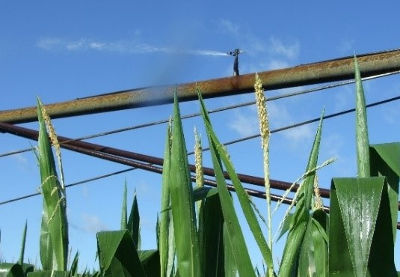By Lyndon Kelley
Irrigator in field
The delay in corn development this year has resulted in a competition for irrigation water on many farms. Maximum water use in many corn fields this year will be between the last week of July and the first three weeks of August. Soybeans in many areas have hit the R3 growth stage, and their time of greatest water benefit will be during the same weeks.
For irrigators with limited water supply capacity, it is typical to plant a combination of corn and soybeans on land that shares the same water source. In a normal year, corn will have developed through its maximum period of water use and be reducing its water needs by the time the soybeans hit R3, where the need for irrigation is the greatest to provide yield increase.
Irrigated corn has its highest water use and realizes its greatest potential benefit from irrigation during the week of tasseling and the following three weeks. Most irrigation scheduling programs have corn using 120% of reference evapotranspiration (rET)—the amount of water used in a day by well-watered 6-inch grass during this period. This translates to a need for as much as 2 inches per week in corn fields during this time.
The reference evapotranspiration for an average mid-August day is 0.19 inches per day or 1.3 inches per week. According to the Southwest Purdue Agricultural Center Weather Data website, to convert rET to crop water use, multiply the rET by a crop coefficient value (Kc). In the three weeks following corn tasseling, the crop will use 120% of the rET or a Kc of 1.2. That results in about 0.23 inches a day (1.6 inches per week) of water use. A cool, cloudy week would result in a corn water use of 1.4 inches and a hot dry week would result in a corn water use of 2 inches.
Indiana producers may use data from their own Et gauge station or rET data from Purdue Agricultural Centers (PACs) weather stations to estimate crop water use. Simply multiply the published number by the Kc of 1.2. If you multiply that result by 7 (days), you obtain the estimated corn water use per week. This information is found at the Southwest Purdue Agricultural Center Weather Data website.
Michigan producers (and Indiana producers in the adjacent counties) can have daily rET data sent to them by email or text by signing up for the service on Michigan State University’s Enviroweather website. Messages are sent at 5:30 a.m. each day providing rET data for the previous four days and estimates of projected rET for the following seven days from any of the network’s 87 stations. Estimates of rET can also be found by going to the Enviroweather website, selecting the station closest to you on the map and scrolling down to the “Water-use tools” heading.
Irrigator
Photo by Lyndon Kelley, MSU Extension.
To make the best use of irrigation water, producers should provide five or six days worth of crop water use per application, typically 1 to 1.25 inches. These larger irrigation applications increase the amount of effective water available to the crop by reducing the water lost by evaporation in the corn canopy and on the residue and soil surface. Evaporation losses amount to about 0.1 inches per application regardless of the amount of irrigation water applied. A producer making two 0.5-inch applications provides 0.8 inches of effective water, compared to a producer making a single 1-inch application that provides 0.9 inches of effective water. Irrigators with center pivots that apply water faster than the soil can infiltrate are forced to use smaller applications (less than 0.5 inches) to avoid irrigation runoff.

From an irrigation standpoint, there is no major advantage or disadvantage of irrigating crops either during the night or day. Avoiding afternoon irrigation, making multiple small applications, and using pivot drop nozzles are all management practices developed for the arid west and have little to no advantage in irrigating Indiana and Michigan fields. However, incidence of tar spot is on the increase this week (as of Aug. 8, 2019) across portions of southwest and west Michigan, particularly in fields under irrigation. In 2018, several growers reported seeing reduced yields on irrigated portions of their fields impacted by tar spot. Unfortunately, we do not have enough data to provide guidance on the time of day of irrigation or weather conditions at the time of irrigation’s impact on tar spot development. However, we are planning on measuring the duration of leaf wetness in corn on fields irrigated at different times and cloud cover levels over the next couple of weeks. It may be a better plan to apply fungicides to protect your irrigated corn fields and to apply irrigation water when the crop needs, it at least for this year.